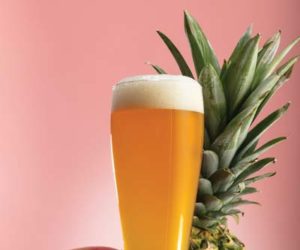Maillard Reactions
Beer contains hundreds of different compounds that interact with our human senses to create the appearance, mouthfeel, aromas and flavors that we experience and enjoy. The compounds that are contained within beer are either derived directly from the raw materials used to produce the beer, or are the result of the malting and brewing process acting upon those raw materials (see Figure 1, below).
Many important compounds found in beer are produced only during the brewing process. Compounds in this category include everything from mashing-derived dextrins, to boiling-derived iso-acids, to fermentation-derived alcohols, esters and phenolic compounds. Other compounds in this category include chemical species that are derived only from the “hottest” activities associated with the malting and brewing process. At the higher temperatures experienced during malt-kilning and wort boiling, a specific group of chemical reactions known as the Maillard reactions can occur.
The Maillard Reactions
The Maillard reaction is named after the chemist Louis-Camille Maillard, who is credited as the first person to describe these kinds of chemical reactions. The Maillard reactions that occur within the malting and brewing process during malt-kilning and wort boiling are a type of non-enzymatic browning that results from a chemical reaction between a reducing sugar and an amino acid, protein, peptide or amine in the presence of an appropriate amount of heat. With appropriate temperature conditions, the reactive carbonyl groups (aldehyde or keto) within a sugar molecule can react with the nucleophilic groups (amine, sulfhydryl, hydroxyl or imidazole) within an amino acid molecule to form a complex mixture of reactant products. These products are comprised of the myriad molecules that are responsible for the colors, flavors and aromas associated with “browning.” Addition-ally, many of these reaction products can undergo decomposition reactions to form still more flavor and aroma compounds, or polymerization reactions to form additional color-active compounds that are associated with “browning.”
The details regarding the specific color, flavor and aroma compounds that are produced during a specific Maillard reaction depend upon the amino acid species, the sugar species, and the specific nature of their reaction. Since there are many different ways that a particular amino acid can react with a particular sugar via the Maillard reaction, there are many, many possible reaction products. Figure 2, on page 90, shows the carbonyl groups within sugars and the nucleophilic groups within amino acids that can be involved in the Maillard reactions. Figure 3 on page 91, provides an illustration of the major Maillard reaction pathways.
The rate and extent of the Maillard reactions is affected by temperature and pH. Increasing temperature increases the rate of the Maillard reactions. Temperature-time heating profiles also play a role in the extent to which higher molecular weight colorant compounds are produced via the Maillard reactions. Higher temperatures, to a point, favor the production of higher molecular weight species.
The Maillard reactions are also accelerated in an alkaline pH environment. This is because the nucleophilicity of the appropriate functional groups within an amino acid molecule is increased as the amino acid molecule becomes more and more deprotonated with increasing pH. Additionally, pH influences preferred reaction pathways is such a way that melanoidin production via Maillard reactions increases with increasing pH, up to a pH of about 9.
There is another distinct category of reactions that can cause browning and changes in flavor and aroma. Caramelization reactions can cause browning and flavor and aroma changes that are often perceived to be similar to the changes caused by Maillard reactions, but caramelization reactions are entirely different. Caramelization occurs when sugars undergo thermochemical decomposition (pyrolysis) at elevated temperature conditions. In contrast, the Maillard reactions always involve reactions between a sugar and an amino acid, protein, peptide or amine.
Maillard reactions associated with the malting and brewing process occur primarily during the kilning of malt and during the wort boiling process. Products of the Maillard reaction influence the color, flavor and aroma of the finished beer. Melanoidins produced by the Maillard reaction produce color compounds that darken beer. Additionally, melanoidins and other compounds produce flavors in beer that are often described as toasty, malty, caramel, bready and roasted. A brewer can control the amount and types of Maillard-derived reaction compounds that are in beer by selecting appropriate types and amounts of kilned malted barley in beer recipes. Using more and darker malts will increase the content of Maillard reaction products in beer and will produce a darker beer with more toasty, roasted aroma and flavor.
A brewer can also influence melanoidin content in beer by using decoction mashing techniques. Decoction mashing involves removing a portion of the grain from the main mash, then boiling them and returning them to the main mash. Boiling the grains causes Maillard reactions to occur and generates the melanoidins that can create a rich, malty flavor.
Another way that a brewer can influence the amount of Maillard reaction products in beer is by changing the duration of the boil. Longer boiling times lead to increased production of Maillard reaction products and can result in a darker, richer tasting beer. The downside to using boiling time to increase Maillard reaction products is that the Maillard reactions happening in the boiling vessel are reducing the amount amino acids and peptides in the wort. Reducing the amount of amino acids and peptides in the wort is not a bad thing, but the brewer should weigh using this technique against the need for free amino nitrogen (FAN) by the yeast, and any potential loss in the body and mouthfeel of the beer to the diminished protein content.
Figure 1: Origin of Some Important Flavor and Aroma Compounds; Illustrations by Chris Champine
Figure 2: Carbonyl Groups Within Sugars and Nucleophilic Groups Within Amino Acids
Figure 3: Primary Maillard Reaction Pathways






